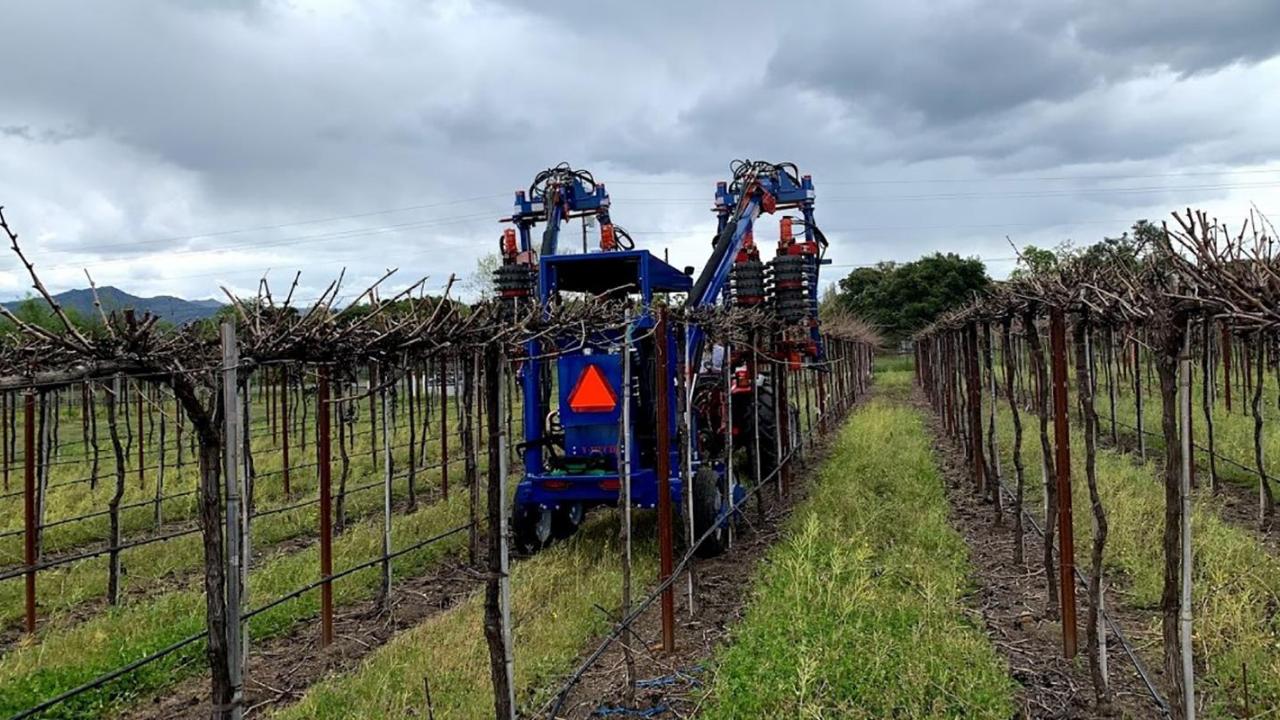
In the vineyards of the future, “There will still be people, just not that many,” says Kaan Kurtural, viticulturist/enologist at the University of California, Davis.
“Today, 90% of our wine grape acreage is mechanically harvested,” he says. “No human touches it and we’re working on mechanizing some of the remaining items like pruning and shoot and leaf removal.”
With mean acreage of California vineyards now around 250 acres and cost of labor listed as one of the most important issues in 2020, more mechanization may be the answer.
Kurtural’s trial-and-error efforts take place at the UC Davis Viticulture and Enology Oakville Station in Napa, a 40-acre research vineyard on two plots, South Station and Old Federal Vineyards.
“Nowhere in the world are there research vineyards of such prominence,” reads UC Davis publicity. “For more than 50 years, the department has conducted critical viticulture research at this site including trials of clones, rootstocks, vine spacing, pruning levels, irrigation…and more.”
Kurtural and colleagues outlined some of their efforts at a Grape Day event for the Napa Valley Vineyard Technical Group, things like spore detection to schedule powdery mildew sprays and a recirculating sprayer to limit drift in areas of urban sprawl. Other topics included applied water amounts, infrared thermometers, mechanical shoot thinners, and unmanned aerial vehicles for spot spraying.
“We put in a model vineyard in 2016,” says Kurtural, “figuring it would be a decade or so before mechanization would be needed in the Napa Valley. And very soon we realized we’d made the right decision because already there’s nobody that wants to work the vineyards.”
Currently involved in diversified topics like soil sensing and evapotranspiration, this place is like a living laboratory on automated pruning and shoot removal and determining management zones by proximal sensing.
Moving toward automation
“There are certain practices we can do and we’ve set out to automate them as we move toward finer points of management,” he says. “Our work on electromagnetic induction soil sensing in the vineyard has cascaded into plant physiology and wine composition — and we’re making new discoveries.
“Of immediate benefit to grape growers is that the current lack of hand labor becomes less of a problem as we can do just about everything by machine. This could save 85%-90% of labor operations costs.”
Science also comes into play when it comes to variability of soil composition.
“We can divide up irrigation zones to produce higher performance by delivering water only where, and when, it’s needed,” he says.
Current work involves proximal sensors and because of their expense, Kurtural is working to identify specific soil zones which will reduce the number of sensors needed in each vineyard. Results of that research are anticipated in the coming months.
Also under close scrutiny is water itself and how much is needed to get a beneficial return.
“Growers get paid by the ton and climate change is making things warmer which means more hydration is needed,” he says. “We’re trying to determine what kind of return growers can get if they apply 6 inches of water per year versus 12 inches. It’s all related to yield and quality parameters. We’re looking at things that people have talked about for 20 years, but no one has looked at them in a planned manner.”
Because Kurtural works in the present to discover the past and apply it to the future, he’s also working on greenhouse gas emissions, carbon sequestration, and some climate change trials as well. All research designed to make life a little easier (and hopefully a bit more profitable) for grape growers.
Asked how he was feeling about this year’s crop and feedback he is getting from the field, his optimism of a trending index was muted.
“It’s tough to get a contract and get grapes sold and people are looking more and more to cut costs all along the line because they don’t know what the future holds,” he said. “That’s why this mechanization trend is so favorable and its popularity is going up and up.”
